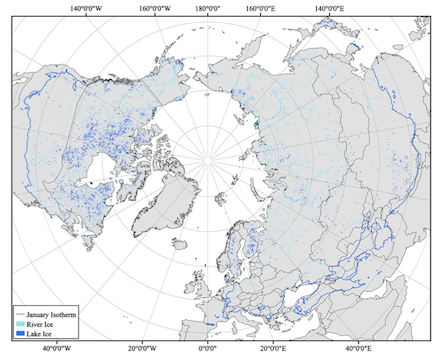
and rivers (light blue) in the circumpolar Arctic (Brooks et al.,
2013). Click figure for larger image.
Through the implementation of hydroclimatic modeling methods, Brooks et al. quantified the distribution of freshwater (lake and river) ice across the Northern Hemisphere. Figure 1 displays the predicted locations of peak freshwater ice in lake and river systems in the circumpolar Arctic (Brooks et al., 2013).
Generally, lake ice occurs in areas above the winter 0°C isotherm (altitude of the freezing point) in the Northern Hemisphere. Additionally, ice is distributed in regions with relatively low annual atmospheric temperatures. Precipitation in the form of snowfall during the winter months allows ice growth at higher concentrations than areas of high rainfall. From Figure 1 it is clear than a vast majority of lake ice occurs in the continental regions of the Canadian Arctic. These regions have mean January temperatures of around -20 to -30°C and moderate winter precipitation around 15-25mm per month (Brooks et al., 2013).
The following table displays the predicted area and peak ice volume of Northern Hemisphere lakes, modelled by Brooks et al., 2013. The area was obtained using GIS techniques, and the ice volume by ice thickness modelling techniques.
| Area (km2) | Ice Volume (km3) | |
|---|---|---|
| Large lakes & reservoirs | 790,000 | 560 ± 120 |
| Small to medium lakes & reservoirs | 800,000 | 860 ± 130 |

circulation patterns and influences on freshwater ice cover
duration (Prowse et al., 2011). Click figure for larger image.
In addition to geographical influences, atmospheric-ocean coupled circulation also have significant effects on lake ice distribution and seasonal ice duration (Figure 2). During periods of El Niño, positive Pacific Decadal Oscillation and positive Pacific North American patterns, warmer temperature phases influence the western Canadian Arctic, leading to shorter ice durations. This occurs because the Aleutian low deepens, allowing warm air intrusions, particularly in spring. In contrast, during negative phases of the above atmospheric patterns, the opposite temperature anomalies occur (Prowse et al., 2011).
Conversely, the positive North Atlantic Oscillation and Arctic Oscillation influence northern Europe, Greenland, northern Asia and northeastern Canada. During this phase, the Icelandic low-pressure system deepens, leading to cooler temperatures in Canada and Greenland as well as warmer temperatures in Europe and Asia. During periods of negative oscillations, the opposite anomalies occur (Prowse et al., 2011).
Material on this page was provided by Maren Pauly, Department of Geography, University of Waterloo.
